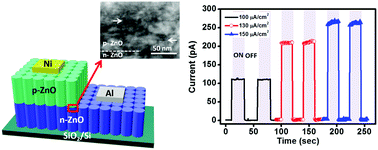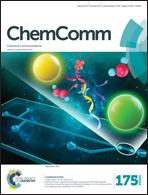Low-temperature-grown p–n ZnO nanojunction arrays as rapid and self-driven UV photodetectors†
Abstract
In this study p-type ZnO nanorod (NR) arrays were grown using a low-temperature hydrothermal method in the presence of various concentrations of Sb in the doping solution. X-ray photoelectron spectroscopy revealed the atomic percentages and chemical states of the Sb dopant atoms in the p-type ZnO NR arrays. Photoluminescence and electrical measurements confirmed the p-type characteristics of the Sb-doped ZnO NR arrays. Sequential growth of n- and p-ZnO was then implemented to form p–n ZnO nanojunction arrays. The photovoltaic properties of the p–n ZnO nanojunction devices were investigated under 365 nm UV light; the short-circuit current densities and open-circuit voltages exhibited linear and logarithmic dependence, respectively, on the power density of the UV light. In addition, the p–n ZnO nanojunction devices displayed a rapid response to UV light at zero bias, with a linear correlation between the responsivity and the incident light power. Such low-temperature growth of p–n ZnO nanojunctions appears to be a facile strategy for fabricating junctioned nanostructures with applications in energy-harvesting and self-driven photodetecting optoelectronics.


 Please wait while we load your content...
Please wait while we load your content...